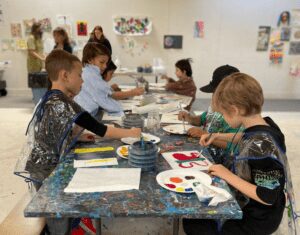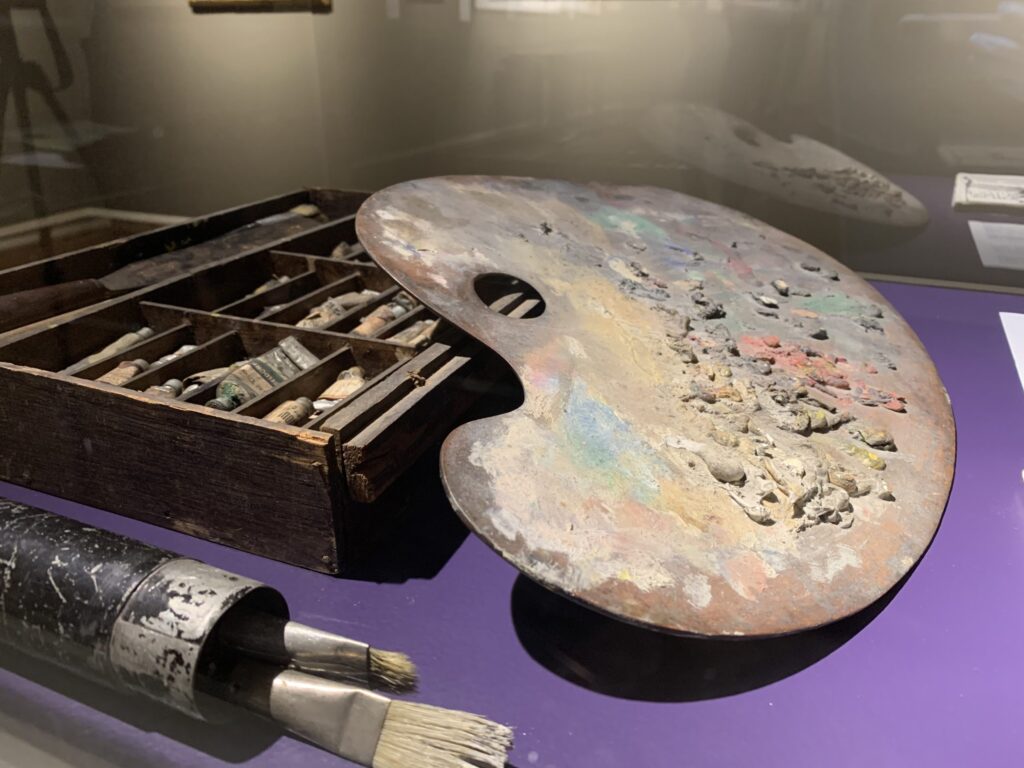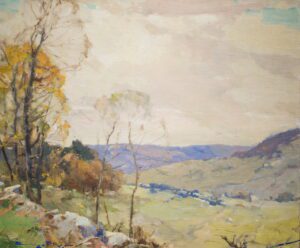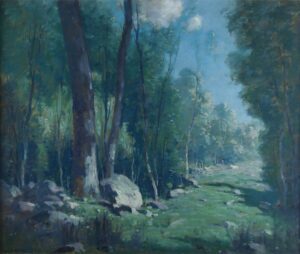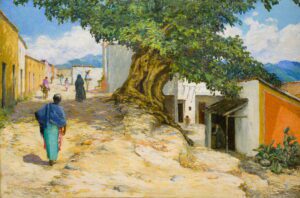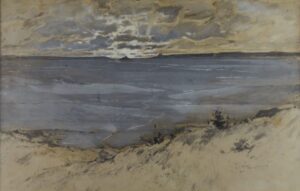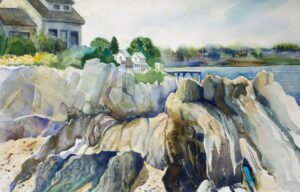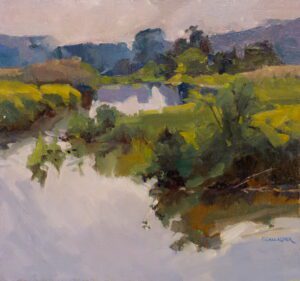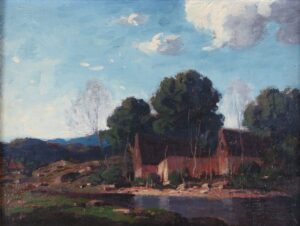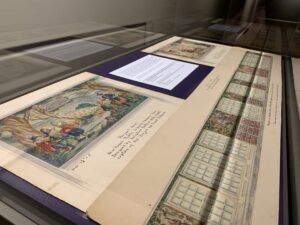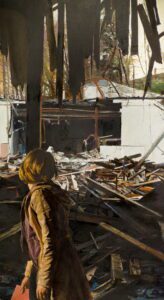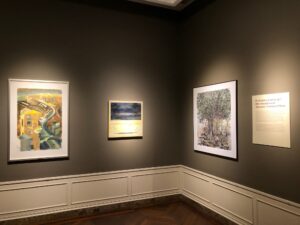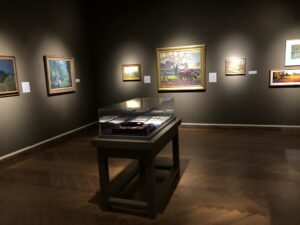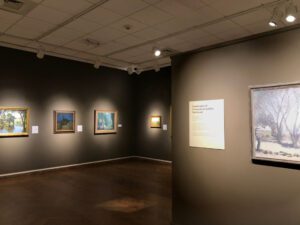January 31 – May 10, 2020
The New Haven Paint & Clay Club, established in 1900, is the oldest continuously active art club in Connecticut. With a history and impact extending far beyond New Haven, the club draws members and exhibitors from across Connecticut, New York and New England.
The art in this exhibition explores place and regional identity. Traditional landscapes depict the land, water, people and locales that help shape our conception of the Northeast. Other works by Connecticut artists portray abstracted landscapes and imaginative or distant places. Drawn from the collection of the New Haven Paint & Clay Club and augmented with works by Club members from the Lyman Allyn and the New Haven Museum, this retrospective celebrates the history and continuing legacy of the Club in its efforts to support and encourage the visual arts.

Beginnings of the New Haven Paint & Clay Club
The New Haven Paint & Clay Club was founded to support the visual arts in New Haven and beyond. Many arts organizations existed in New York and Boston, but artists sought something between these metropolitan centers. Other regional art associations soon emerged, including the Greenwich Society of Artists, founded in 1912, the Mystic Art Association (1913), and the Lyme Art Association (1914), among others. There has long been overlap and exchange between these and other art groups. As can be seen in this exhibit, numerous artists connected to the New Haven Paint & Clay Club were also affiliated with the art colonies at Cos Cob, Old Lyme, and Mystic.
The New Haven Paint & Clay Club’s founders were artists seeking a local venue to exhibit their work, as well as a social and professional network. Many were faculty or students at the Yale School of the Fine Arts, the first professional university art school in the United States, founded in 1864. The first school within Yale to admit women, the Yale School of the Fine Arts was remarkably progressive. It also served New Haven’s residents, as stipulated by the school’s donor and founder, New Haven businessman Augustus Russell Street.
From its beginning, the New Haven Paint & Clay Club was open to women at a time when some established art and social clubs were not. The Club emerged when a variety of progressive clubs were being established to improve communities by promoting education and opportunities in the arts, culture, and in other arenas.
Landscapes of Connecticut and the Northeast
Artist Frederick Lester Sexton, a longtime member of the New Haven Paint & Clay Club, championed Connecticut’s distinctive beauty. “I wonder if one can get any better subjects at any other places,” he mused. “Take our beaches, our wharves, they are wonderfully interesting . . . We don’t need to go away. Beauty is right here.”
Art in this section explores the beautiful, varied landscapes of Connecticut and the region, with views of the shoreline, water, forests, fields, and other natural elements. Many of the Club’s early artists are represented here, including John Ferguson Weir, the first dean of the Yale School of Fine Art and a founding member of the New Haven Paint & Clay Club, as well as George Albert Thompson, the Club’s first President and a founder of the Mystic Art Association.
While traditional methods and modes of depicting the landscape have guided many artists in the 20th and 21st century, other artists have played with color, line, perspective, style, and materials to enliven the landscape genre.
Works Progress Administration Art
The art in this section relates to government-funded projects that were part of Franklin D. Roosevelt’s New Deal, a broad relief program designed to provide work for Americans during the Great Depression. Some Connecticut artists active with the New Haven Paint & Clay Club in the mid-to-late 1930s and early 1940s received funding from the Works Progress Administration (WPA). The WPA supported artists in their work as easel painters and printmakers, and government-funded mural projects provided work for artists decorating municipal building—schools, libraries, post offices, and courthouses in New Haven, New London, and elsewhere.
The New Haven Free Public Library was a significant Connecticut site for WPA Federal Art Project murals. Bancel LaFarge, the father of Thomas LaFarge, painted two lunette murals for the library’s main hall, and a large mural project was executed in the Children’s Room of the library. A competition was held to help select the artists and designs for the Rip Van Winkle mural. These winning sketches were submitted by Salvatore DeMaio, a member of the New Haven Paint & Clay Club, with the assistance of Frank Rutkoski. DeMaio, Rutkowski, and assistants executed the murals.
Urban Spaces and the Built Environment
The art in this section explores the built environment, focusing on architecture, industry, transportation and people in urban spaces. From 1900 to the present, artists of the New Haven Paint & Clay Club have depicted Connecticut and the Northeast, documenting the changing world around them. Guy Wiggins painted New York City at the turn of the 20th century with horse-drawn wagons in the streets, while William Meddick’s The Sign (1995) shows New Haven from the junction of highway I-95 and I-91, a very different urban view.
Artists have long been attracted to the energy and formal beauty of cities, sometimes championing and sometimes critiquing notions of progress and industry. For some, the character of Hartford or New York can be found in views of people moving through dense public spaces, while other artists emphasize architecture. Given the coastal geography of this region, it is not surprising that maritime industry, with its developed waterways and scenes of docks and boats, has also long been a favorite subject for artists.
Rethinking Landscape: Dreamscapes and Alternate Visions of Place
How have recent artists in Connecticut and the region rendered the world around us amidst vast changes in society, politics, economics and the environment? Some have explored space, place, and identity by approaching landscape in different ways, challenging and expanding the genre. Leo Stoutsenberger’s Recrementia is a landscape composite, with watercolor segments cut and reconfigured to offer tiny glimpses of traditional scenes. Wendy Brest’s mixed-media Outer Suburbia presents colors, textures, and materials in a seemingly haphazard composition, suggesting the bleakness and often unplanned jumble of the suburban environment.
Some artworks in this section explore the realm of the imagination with unusual or idealized landscapes that are dreamlike and personal. With bold color, Hannah Jung’s Come to the Water shows stylized birch trees rising out of a pool of calm water, offering a contemplative scene. Nancy Eisenmann’s Road Trip has a surreal edge, viewing the sky through a car’s windshield with clouds moonlit from above, capturing the strangeness of the everyday world.
Views from the Galleries




